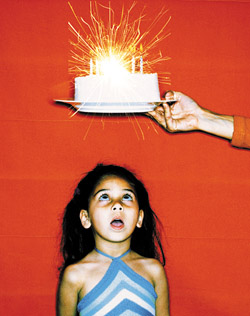Screen Mode
If Multiply mode acts like ink, then Screen mode is its opposite, acting like light instead. In this mode, black simply disappears, while anything brighter than black will brighten the underlying image. Screen mode is useful when you have an image with a black background, with anything that resembles light. I like to use it with things like sparklers and lightning. I just put the sparkler on a layer above another image, set the layer mode to Screen, and then choose Image > Adjust > Levels and pull the upper-left slider in until the background of the sparkler disappears (Figures 13.56 and 13.57).
Figure 13.56. Result of using Screen mode to combine images. (©Stockbyte, www.stockbyte.com)

Figure 13.57. Result of applying Levels to darken the background of the sparkler to black.

Screen mode is used in many of Photoshop's Layer Styles. Let's say you have some text and you add a glow around it by choosing Layer > Layer Style > Outer Glow. That will work fine as long as you choose a color that is bright like white or yellow, but it won't look so good if you use a dark color like navy blue (Figure 13.58). This is because Photoshop uses Screen mode as the default method for applying the glow to the underlying image, and shining a dark blue light at something isn't going to change it much. To remedy the situation, just change the blending mode (in the Layer Style dialog box) to either Normal or Multiply (Figure 13.59).
Figure 13.58. A deep blue outer glow created in the default blending mode: Screen mode.

Figure 13.59. Result of switching from Screen mode to Normal mode.

In my Photoshop seminars, I usually talk about how red, green, and blue light interact to create all the colors that a computer monitor can display. To demonstrate this, I start with a document that has a black background layer. Then I create three layers: one with a red circle, one with a blue one, and the third using green. But when I move these circles so they overlap, they don't interact like they would if they were made by shining a flashlight at a wall (Figure 13.60). By setting each of the layers to Screen mode, I can get the circles to interact with each other as if they were circles of light (Figure 13.61).
Figure 13.60. In Normal mode, the three circles don't interact with each other.

Figure 13.61. Result of switching each layer to Screen mode.

